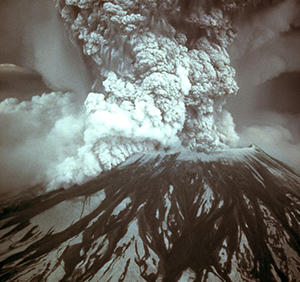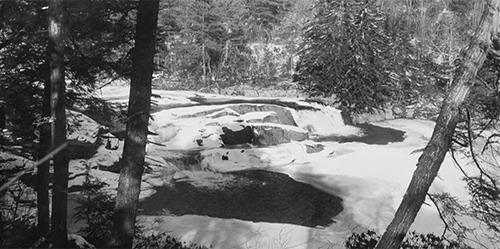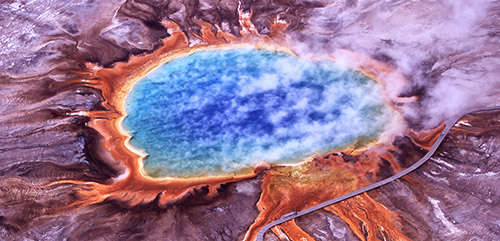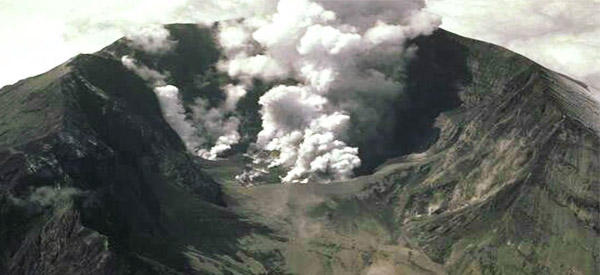The day was April 5th, 1815, before the Industrial Revolution began. The majority of the population were farmers, raising crops to feed themselves and others. But farmers depend on good weather, with abundant rain, sunlight and warmth. This year, they wouldn’t have enough of these key weather elements to ensure a good crop. Food prices would rise and many would go hungry. Thousands would die around the world.
So, what happened on April 5th, 1815? The largest volcanic eruption in human history, registering a Velocity Explosivity Index or “VEI” of 7 out of 8. By comparison, Mount St. Helens, the largest volcanic eruption in recorded American history, rated a VEI of merely 5.
When volcanoes erupt, there’s more going on than spewing forth hot lava, although it is that lava which receives all the attention. Copious amounts of gases and ash are ejected into the upper atmosphere, causing even more serious problems than the lava does. Lava is merely a local event, while the fine ash from a volcano can travel around the world, taking months to come back down to earth.

The two-week long eruption of Mount Tambora in Indonesia spewed 19 cubic miles of ash into the atmosphere. By comparison, Mount St. Helens releases ¼ of a cubic mile. Much of that ash, especially the larger particles, came down within a few miles of the volcano, dropping a layer of ash 12 feet thick over an area one hundred miles on a side. But it was the finer ash which caused widespread problems, for it went higher into the upper atmosphere, but stayed up there, causing a volcanic winter.
Ash was so thick in the ocean, that shipping had to struggle to push through it. Several tsunamis were also caused by the eruption, causing widespread damage and destruction.
Related: US Official Procedures Before SHTF. How to Know Before It Hits
The Impact
Opinions vary, but climate scientists state that the overall temperature of the earth lowered by between one and three degrees Celsius. But that figure is an average. In Europe and New England, weather patterns were severely affected, causing heavy snow on June 6th, 1816. Drifts of 18 to 20 inches high were recorded in Philadelphia.
Tons of fine ash particles were blown into the stratosphere, where they blocked the sun’s rays. In addition to the ash, there was sulfur dioxide, which combined with water vapor to create sulfate aerosols that reflect the sun’s rays, adding to the problem caused by the ash. The colder temperatures and lack of sunlight affected crop growth. Between the two, there wasn’t enough sunlight to warm the earth or for plants to use to grow properly. But it wasn’t just the newly founded United States that was affected. Wet conditions in Europe and Asia rotten many crops in the field, before they could mature to harvest.
The colder temperatures and lack of sunlight affected crop growth. Between the two, there wasn’t enough sunlight to warm the earth or for plants to use to grow properly. But it wasn’t just the newly founded United States that was affected. Wet conditions in Europe and Asia rotten many crops in the field, before they could mature to harvest.
These widespread agricultural problems caused countless people to die of starvation. There is really no accurate count as to how many suffered and died for lack of food. But that wasn’t the only thing that people were struggling with, as disease flourished in the altered climate. It is quite likely that the Cholera epidemic of the 19th century owes its success to the Mount Tambora eruption.
While the impact of the volcano’s eruption were widespread and devastating, they were also somewhat short-lived. By 1817 temperatures returned to normal and the volcanic winter was over. But for many people, the effects of that eruption changed their lives forever.
Could it Happen Again?
There are still approximately 1,500 volcanoes in the world today, not counting the belt of volcanoes on the ocean floor. Many of those volcanoes are located along the Pacific Rim, in what is known as the “Ring of Fire,” a region of geologic instability, due to converging plates.
As the Mount Tambora eruption proves, even those volcanoes on the other side of the world, could have a devastating effect on us. But those aren’t the greatest danger, as here in the United States, we have 169 volcanoes which scientists consider to still be active. The majority of those are located in Alaska, the Northwestern part of the country and Hawaii. Eruptions in Alaska happen virtually every year; but they go largely unnoticed, due to the low population of Alaska.
However, the biggest and most dangerous American volcano isn’t in these areas; it’s in northwest Wyoming . The Yellowstone Supervolcano, which scientists have been warning us is overdue for an eruption, sits in the midst of one of the country’s top vacation destinations. Yet underneath the ground, the heat which causes all the beauty that people go there to see creates a very dangerous situation. When the Yellowstone Supervolcano finally does erupt, it could rival Mount Tambora for its destructive power. There is really no way of knowing, until it happens. While scientists know and can measure some of the precursors to an eruption, that only gives a few day’s notice. There is no known was of predicting volcanoes beyond that narrow window.
When the Yellowstone Supervolcano finally does erupt, it could rival Mount Tambora for its destructive power. There is really no way of knowing, until it happens. While scientists know and can measure some of the precursors to an eruption, that only gives a few day’s notice. There is no known was of predicting volcanoes beyond that narrow window.
It is estimated that an eruption of the Yellowstone Supervolcano would spew ash for over 1,000 miles, with the first 600 miles from the volcano receiving enough ash to kill crops and even animals. People living within a couple hundred miles of the volcano would have little chance of survival, while those living farther away would survive, but only to struggle though the volcanic winter that the eruption would cause.
A large part of the ash that would be spewed out of the volcano would land in the Midwest, blanketing the Breakbasket of America, the country’s and the world’s most productive farmland.
While the actual chances of an eruption are extremely low in any one year, Yellowstone will eventually erupt. When that will happen is anyone’s guess, and has been the source of much apocalyptic writing. How severe is another guess, as the volcano could have a much smaller eruption, rather than the massive one that everyone expects. In either case, those who are closer will obviously feel the heat much more than the rest of us.
Should a massive eruption occur in Yellowstone, there is the possibility that it could rival Mount Tambora or even surpass it. Should that happen, we might find ourselves in a volcanic winter that lasts several years, causing incredible damage and millions of deaths.
You may also like:
 9 Places to Scavenge After SHTF
9 Places to Scavenge After SHTF
The Common Vegetable That Will Increase Your Heart Attack Risk At Least Two-Fold (Video)
The 3 US Super Volcanoes That Can Destroy the World as we Know it!















One way to know for certain if the Yellowstone eruption is imminent is if elk, bison, and grizzly bears are hiding under beds in New York and Southern Texas.
There might be as many elk in Texas as in Wyoming, ranchers all over the state raise them as part of their exotic game hunting packages. Last fall driving up HWY 385 between Marathon and Ft. Stockton I saw a beautiful bull elk with a full rack of antlers grazing along the shoulder. Probably more bison here, too, the Yellowstone bison are descendants of the herd Charlie Goodnight kept up on the caprock, they were the last genetically pure bison in the world, the rest having been crossbred with cattle. Sadly, the last Grizzly in Texas was shot for sport back around 1930.
I listen to Charlie Frost on the radio late at night, he keeps an eye on that volcano
The other problem mostly unmentioned except by a few special scientists is the slight few degrees of axis change to the planet it’s self. That adds to the short term and long term change’s in area crop growth and climate. Hard to prepare for such widespread hardship yet folks do survive and life goes on.
Food and water stores will help in the relative short term. What if it’s hard to grow crops and live for several years? Then what? Even solar power could be close to useless? Storing that much fuel wouldn’t be possible for most of us.
Glad my second well is fine mountain water in a deep lava tube and it’s being set up for both solar pumping and manual drawing. Yup I live at the foot of a volcano that last erupted more than 1200 years ago. Sometimes you wonder…what if… Can’t live in fear of every conceivable disaster but we can prepare for most.
Sorry. Auto correct changes the last eruption time. It is 1,500,000 years ago according to scientists. So not too worried about. It just makes a lovely mountain above my high desert home.
remarkably rational…
Hello, the earth does NOT move in ANY way. Earth is FLAT and geocentric. You might want to research this information. There are many falsehoods being spewed as Truth, the spinning ball earth is the biggest , in MHO !!
Thanks for that, Ken, but I really hope you’re not serious. The Earth is not flat. There is no possibility of it being flat. Its non-flatness was solidly established by the ancient Greeks.
Or, ya’ know, we might not.
well, the “truth” has been known since the late 19th century, and confirmed many times since then. We live in a Heliocdntric system, and, as Galileo himself sais to Il Papa, “it all moves!:
It’s been known much longer than that. An ancient Greek philosopher – I can’t remember his name off the top of my head – didn’t just prove that the Earth is a sphere; he worked out its diameter to within a couple % of the right number, using a well and a couple of sticks.
A Greek did this in Egypt, using wells about 500 miles apart and then measuring the sun’s angle at noon on the same day. The difference in the sun’s angle have him the arc length for the circumference of the earth!
Earth is a geoid,not a sphere.
Didn’t mean to do thumbs down, meant thumbs up.
Just establishes the fact that when the EOTW happens, folks who are barely maintaining on their meds will go off the deep end.
A case that dragged on for a long time in Orange County CA Superior Court involved a well-spoken, apparently well-educated man who appeared to have adequate income to dress well but in a somewhat old-fashioned style. He was articulate and his legal arguments, while novel, were thoughtfully founded and drove the city attorney of San Clemente crazy for almost a year. He was representing himself, what we legal beagles called “pro per.”
All that was until you asked him about the voices. (cue music from one of that science fiction TV thrillers) He told us he had put aluminum foil on his windows to help block the voices. All in a reasonable, intelligent manner. I don’t know if he took medication or not and inasmuch as this was in the early 60s, I suspect that he did not. After his case was over I never saw him agin. He was a very interesting individual. Not committable but certainly had some interesting ideation as the shrinks like to say.
While a super volcano erupting certainly would spoil my plans for the summer, I would take comfort in the fact that the rest of the world would be enjoying the same misery we were in. We wouldn’t have to worry about a sneak attack by some ideologue who felt compelled to try to rule the world.
The same applies to a massive CME. You know the old saying, “Misery loves company.”
If the rest of the world is also scrambling to find their next meal and cup of clean water, we don’t have to worry about them mounting an attack on our shores. We may have to build that wall that The Donald keeps talking about and in the case of a volcanic winter, we may have to build one on our northern border too because if it is freezing in Miami, you can imagine what it is like in Moose Jaw, CA. (that’s Canada, not the PDRK)
On the other hand, an EMP or an attack on our grid would leave us vulnerable to opportunists of every ilk. Some strange bedfellows might even join forces to teach the U.S. a lesson (May of the U.K. and Merkel of the German Republic???) While I certainly think they might bite off more than they can digest, that wouldn’t be much help to us. It would be a Pyrrhic victory for us. The Russians won the war but lost the battle. The German/Russian kill ration was 10/1 up until the Germans decided it was a lot cause. Then it really was. Had Russia had the same population as Germany there would be no Russia today.
As one Chinese general bragged to his American counterpart at Panmunjom, “I can lose 1 million men and still have the largest army in the world. Can you?”
We would eventually prevail but the losses to our country would be staggering. There wouldn’t be any Marshall Plan to help us recover from our war losses.
As some pundit as said, “I don’t know what weapons WWIII will be fought with, but WWIV will be fought with sticks and stones.”
So while I wouldn’t welcome a super volcano eruption, it is way down on my list of items to spend a lot time thinking about. One bright side to it would be that it would silence all those nattering nabobs of global warming.
Haha! Should Yellowstone go up, or some other thing affect the US dramatically, Mexico may be building the wall instead of us, to keep us from moving south to warmer climes, especially if Miami is freezing. The Canadians would’ve already moved south before we could even consider building such a wall on our northern border in such a climate.
Of course, I’m still waiting for that long-predicted New Madrid earthquake. I remember that back in 1997, they were saying that it was imminent with an 80% chance that it would happen before 2000. I figure that’s still a lot more likely than Yellowstone, which the non-doom-sayers are saying may happen in the next 100,000 years.
If you want to read a chilling book about the New Madrid fault, “Rift” is fictional account of a new earthquake along the New Madrid fault and what effect it would have on the folks in the area.
Interspersed in the book are excepts from newspaper articles and letters from folks who were living through the 1812 New Madrid earthquake. I don’t know if it is scientifically established or not, but the author starts his novel with a compelling description of an earthquake along that fault line in the pre-European era.
It is an interesting read and certainly out of the usual EMP/CME survivalist line of novels.
I think that was Churchill? As for global warming, I think it’s from a hearing up of the earth’s core! When nuclear reactors were first built they discovered the reactions does up and slowed down akternatively, until they coated the rods with cadmium. Well, the nuclear materials at the earth core aren’t coated! Figure it out!
Hello, the earth does NOT move in ANY way. Earth is FLAT and geocentric. You might want to research this information. There are many falsehoods being spewed as Truth, the spinning ball earth is the biggest , in MHO !!
Lol. My part of this earth is neither flat nor round.
What a way to stop the conversation
Ken, you may want to check your facts. The conversation reminded me of something that I read a while back, so I went looking. Check this out: https://www.nasa.gov/topics/earth/features/japanquake/earth20110314.html
Your a different kind of stupid….
Well said LCC. A super volcane would do a bit more than mess up my summer. But many will go on and at least survive.
Willing learners and willing workers will have a chance. The lazy will have no chance. If I were to survive the initial situation I’d hope to keep learning and teaching.
We can’t judge everything by personal experience alone. Nor should we dismiss personal experience. It is in the many experiences and varried experiences from which we gather information and knowledge and make informed decisions and hopefully wiser plans.
If I judged life by the tall green forrest above me or the valleys below me… I’d not survive in the hills and canyons where I live. Each place has things similar yet very different. We need a variety of information gleaned from many sources. That is the reason I enjoy the discussions in these rooms.
I guess oddballs bring an element of entertainment but I’m more interested in learning things that are helpful.
https://www.youtube.com/watch?v=fou7yRkfepo
Folk song about same by Pete and Karen Sutherland
A lot of scientists think that if the Yellowstone volcano blows, the effects could be a lot worse even than this article describes. An earlier eruption dumped up to 3 feet of volcanic ash for thousands of miles around. Volcanic “ash” isn’t soft fluffy stuff; it’s actually pulverized rock, and if you inhale any amount it will lacerate your lungs. Surviving the initial fall of ash is going to need the same techniques – and pretty much the same kind of refuge – as surviving nuclear fallout. It isn’t radioactive, but you still need to have a sheltered place with a clean air supply to retreat to until the ash stops falling.
Having researched several sources on weather history I think a correction should be made. These drifts referred to in the article occured in northern new england, NOT in Philadelphia. While the history is extraordinary, there is no need to embellish. Truth is stranger than fiction
If the US continues to fall away from God, Yellowstone blowing up might be his ultimate “spanking”. For sure, grain prices will come out of their price slump!!!
It’s an ill wind that blows no good — at least that’s what the old proverb says. Don’t know if I agree. However, no good examples either way.
When the schizen hits the fan many will be hoping for globull warming.
Lol. Yes. Our winters easily show us -10 or -20 night. Must have a source of heat to survive.
Not to mention the fact that a major eruption will mess up air traffic. Do you all remember when that volcano in Greenland erupted a few years ago? Ash settlement also depends on the length of time the volcano is actually erupting, too. Often, they can erupt for months or years. On the plus side, ( if you can call it that), volcanic soil is very fertile and eventually when we’re able to plant crops again they should do very well for some time to come.
See my comment about ill wind above, Miss Kitty. You are right, volcanic ash is supposed to be good for crops.
LCC I bet the book about the new Madrid fault is an interesting read. Geology shows there were not a lot of major quakes. It just built up pressures until an extra big slip occured and did major damage in a widespread area. It’s happened a few times with so much damage it even made the mighty Mississippi River run backwards along a long stretch of the river.
Having been through a few big shakes in California I wouldn’t want to be in on that one when it comes. I don’t want to be in a another major one in California. My first one about 1952 would have been plenty. Several lesser ones didn’t endear them to me at all. I hate earthquakes and I hate tornadoes, wild fires and thieves. All from the perspective of experience.
I don’t need to add volcanic erruption to my life experiences. Thanks but I’d prefer to pass on that one.
Hey all you preppers! Read the verses from Isaiah 37:30-32 & Hoses 6:1-2 and see if it doesn’t suggest that after the “big one” well have to wait for 2 years before we start farming again? (Note Hoses is in prophetic time, while there’s no suggestion the Jews actually had to follow the advise given by Isaiah. Ergi, Isaiahs advice is for a mother time!)